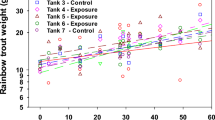Abstract
Decabromodiphenyl ether (BDE 209) is the main congener in the commonly used commercial flame retardant mixture, “deca-BDE”. There is evidence showing that fish can debrominate BDE 209 into potentially more toxic congeners. The objective of this study was to evaluate BDE 209 uptake and its potential effects on juvenile lake whitefish (Coregonus clupeaformis). Lake whitefish were fed BDE 209 at four nominal concentrations (control, 0.1, 1, and 2 μg/g-diet) for 30 days. Livers and carcasses were analyzed for 11 polybrominated diphenyl ether (PBDE) congeners (BDE 47, 99, 100, 153, 154, 196, 197, 206, 207, 208, and 209) and daily otolith increment width was measured as an estimate of growth before and after exposure. Four congeners (BDE 206, 207, 208, and 209) were detected in livers and carcasses. Hepatic BDE 209 concentrations in the 1 and 2 μg/g treatments were significantly higher than in the control group (1.25 and 5.80 nmol/g-lipid compared to 0.183 nmol/g-lipid). The concentration of BDE 209 detected in the tissues of the control group resulted from BDE 209 in the base diets. Concentrations of all congeners from the 1 and 2 μg/g groups were higher in livers than carcasses, indicating the liver was the primary organ of BDE 209 accumulation. Compared to the fraction in diets, the molar fraction of BDE 209 was lower in livers and carcasses, whereas the fractions of BDE 206, 207, and 208 were higher. These different distributions of PBDE congeners resulted from differential adsorption and metabolism. One congener, BDE 206, could be a major metabolite from BDE 209 debromination. Otolith increment widths were narrower in fish from the highest diet concentration administered, suggesting BDE 209 may have affected growth rates. In conclusion, this in vivo study with lake whitefish showed that BDE 209 was debrominated into lower PBDE congeners and that exposure to 2 μg/g may have affected fish growth.




Similar content being viewed by others
References
Alcock RE, Sweetman A, Jones KC (1999) Assessment of organic contaminant fate in waste water treatment plants I: selected compounds and physicochemical properties. Chemosphere 38:2247–2262
Anderson TD, MacRae JD (2006) Polybrominated diphenyl ethers in fish and wastewater samples from an area of the Penobscot River in Central Maine. Chemosphere 62:1153–1160
Agency for Toxic Substances and Disease Registry (2004) Toxicological profile for polybrominated biphenyls and polybrominated diphenyl ethers. U.S. Department of Health and Human Services, Atlanta, p 564
Bromine Science and Environmental Forum (2006) Available via: http://www.bsef.com. Accessed 15 October 2006
Burreau S, Axelman J, Broman D, Jakobsson E (1997) Dietary uptake in pike (Esox lucius) of some polychlorinated biphenyls, polychlorinated naphthalenes and polybrominated diphenyl ethers administered in natural diet. Environ Toxicol Chem 16:2508–2513
Burreau S, Zebuhr Y, Broman D, Ishaq R (2006) Biomagnification of PBDEs and PCBs in food webs from the Baltic Sea and the northern Atlantic Ocean. Sci Total Environ 366:659–672
Campana SE (1992) Measurement and interpretation of the microstructure of fish otoliths. In: Stevenson DK, Campana SE (eds) Otolith microstructure examination and analysis (Canadian Special Publication of Fisheries and Aquatic Sciences 117). McClain Printing Company, Parsons, pp 59–71
Darnerud PO, Eriksen GS, Johannesson T, Larsen PB, Viluksela M (2001) Polybrominated diphenyl ethers: occurrence, dietary exposure, and toxicology. Environ Health Perspect 109:49–68
de Wit CA (2002) An overview of brominated flame retardants in the environment. Chemosphere 46:583–624
Eales JG, Brown SB (1993) Measurement and regulation of thyroidal status in teleost fish. Rev Fish Biol Fish 3:299–347
Gauthier LT, Hebert CE, Weseloh DVC, Letcher RJ (2008) Dramatic changes in the temporal trends of polybrominated diphenyl ethers (PBDEs) in herring gull eggs from the Laurentian Great Lakes: 1982–2006. Environ Sci Technol 42:1524–1530
Hale RC, Alaee M, Manchester-Neesvig JB, Stapleton HM, Ikonomou MG (2003) Polybrominated diphenyl ether flame retardants in the North American environment. Environ Int 29:771–779
Hale RC, La Guardia MJ, Harvey E, Gaylor MO, Mainor TM (2006) Brominated flame retardant concentrations and trends in abiotic media. Chemosphere 64:181–186
Kierkegaard A, Balk L, Tjarnlund U, de Wit CA, Jansson B (1999) Dietary uptake and biological effects of decabromodiphenyl ether in rainbow trout (Oncorhynchus mykiss). Environ Sci Technol 33:1612–1617
Law K, Halldorson T, Danell R, Stern G, Gewurtz S, Alaee M, Marvin C, Whittle M, Tomy G, (2006a) Bioaccumulation and trophic transfer of some brominated flame retardants in a Lake Winnipeg (Canada) food web. Environ Toxicol Chem 25:2177–2186
Law RJ, Allchin CR, de Boer J, Covaci A, Herzke D, Lepom P, Morris S, Tronczynski J, de Wit CA (2006b) Levels and trends of brominated flame retardants in the European environment. Chemosphere 64:187–208
Leatherland JF (1993) Field observations on reproductive and developmental dysfunction in introduced and native salmonids from the Great-Lakes. J Gt Lakes Res 19:737–751
Lema SC, Schultz IR, Scholz NL, Incardona JP, Swanson P (2007) Neural defects and cardiac arrhythmia in fish larvae following embryonic exposure to 2, 2′, 4, 4′-tetrabromodiphenyl ether (PBDE 47). Aquat Toxicol 82:296–307
Li Y, Watkins BA (2002) Analysis of fatty acids in food lipids. In: Wrolstad RE, Acree TE, An H, Decker EA, Penner MH, Reid DS, Schwartz SJ, Shoemaker CF, Smith DM, Sporns P (eds) Current protocols in food analytical chemistry. Wiley, New York, pp D1.2.1–D1.2.15
Lumb CE, Johnson TB, Cook HA, Hoye JA (2007) Comparison of lake whitefish (Coregonus clupeaformis) growth, condition, and energy density between lakes Erie and Ontario. J Gt Lakes Res 33:314–325
Madenjian CP, Fahnenstiel GL, Johengen TH, Nalepa TF, Vanderploeg HA, Fleischer GW, Schneeberger PJ, Benjamin DM, Smith EB, Bence JR, Rutherford ES, Lavis DS, Robertson DM, Jude DJ, Ebener MP (2002) Dynamics of the Lake Michigan food web, 1970–2000. Can J Fish Aquat Sci 59:736–753
Manugian R (2004) Focus on interim chemical action plan for PBDE flame retardants. 04-03-055. Washington state department of ecology, Lacey
McDonald TA (2002) A perspective on the potential health risks of PBDEs. Chemosphere 46:745–755
Morck A, Hakk H, Orn U, Wehler EK (2003) Decabromodiphenyl ether in the rat: absorption, distribution, metabolism, and excretion. Drug Metab Dispos 31:900–907
Oyadomari JK, Auer NN (2007) Influence of rearing temperature and feeding regime on otolith increment deposition in larval ciscoes. Trans Am Fish Soc 136:766–777
Pitcher CR (1988) Validation of a technique for eeconstructing daily patterns in the recruitment of coral reef damselfish. Coral Reefs 7:105–111
Pothoven SA, Nalepa TF, Schneeberger PJ, Brandt SB (2001) Changes in diet and body condition of lake whitefish in southern Lake Michigan associated with changes in benthos. N Am J Fish Manage 21:876–883
Reader JP, Dalziel TRK, Morris R (1988) Growth, mineral uptake and skeletal calcium deposition in brown trout, (Salmo trutta L), yolk-sac fry exposed to aluminum and manganese in soft acid water. J Fish Biol 32:607–624
Simkiss K (1973) Calcium metabolism of fish in relation to ageing International symposium on the ageing of fish. The Gresham Press, Old Woking, Surrey, England, pp 1–12
Stapleton HM, Alaee M, Letcher RJ, Baker JE (2004) Debromination of the flame retardant decabromodiphenyl ether by juvenile carp (Cyprinus carpio) following dietary exposure. Environ Sci Technol 38:112–119
Stapleton HM, Brazil B, Holbrook RD, Mitchelmore CL, Benedict R, Konstantinov A, Potter D (2006) In vivo and in vitro debromination of decabromodiphenyl ether (BDE 209) by juvenile rainbow trout and common carp. Environ Sci Technol 40:4653–4658
Streets SS, Henderson SA, Stoner AD, Carlson DL, Simcik MF, Swackhamer DL (2006) Partitioning and bioaccumulation of PBDEs and PCBs in Lake Michigan. Environ Sci Technol 40:7263–7269
Tjarnlund U, Ericson G, Orn U, de Wit C, Balk L (1998) Effects of two polybrominated diphenyl ethers on rainbow trout (Oncorhynchus mykiss) exposed via food. Mar Environ Res 46:107–112
Wiegand H, Desaiah D, Dehnhardt M, Smolnikar K (2001) Polyhalogenated hydrocarbon induced perturbation of intracellular calcium homeostasis; from astrocytes to human macrophages. Organohalogen Compd 53:182–185
Zhou T, Ross DG, DeVito MJ, Crofton KM (2001) Effects of short-term in vivo exposure to polybrominated diphenyl ethers on thyroid hormones and hepatic enzyme activities in weanling rats. Toxicol Sci 61:76–82
Zhu LY, Hites RA (2004) Temporal trends and spatial distributions of brominated flame retardants in archived fishes from the Great Lakes. Environ Sci Technol 38:2779–2784
Acknowledgments
This study was funded by the U.S. EPA Great Lakes National Program Office (GLNPO) under the project titled “Ecotoxicology of Brominated Flame Retardants in Great Lakes Biota” (Project number GL2005-139). We thank the students and staff at the Purdue University Aquaculture Research Laboratory for help with fish rearing and Dr. Changhe Xiao and Dr. Anant Bharadwaj for laboratory support.
Author information
Authors and Affiliations
Corresponding author
Rights and permissions
About this article
Cite this article
Kuo, YM., Sepúlveda, M.S., Sutton, T.M. et al. Bioaccumulation and biotransformation of decabromodiphenyl ether and effects on daily growth in juvenile lake whitefish (Coregonus clupeaformis). Ecotoxicology 19, 751–760 (2010). https://doi.org/10.1007/s10646-009-0451-x
Accepted:
Published:
Issue Date:
DOI: https://doi.org/10.1007/s10646-009-0451-x




